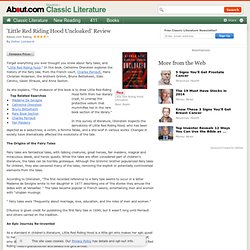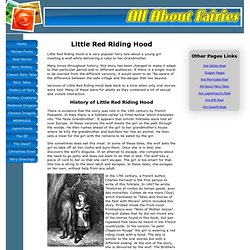

Too old/too soon: Moderating your adolescent's speed of growth. Parents are mixed: they don't want their child to grow up too fast, but they feel complimented when friends say, "Your child acts so grown up! " Although they want to delay exposure to adult information and life experience until they feel their child is old enough to responsibly manage it, when their child acquires performance skills and sophisticated understandings beyond the norm for her age, they feel proud about this advanced level of accomplishment. Through the childhood years up to about age 8 or 9, parents often feel pleased by seeing precocious growth; however, come the advent of early adolescence (ages 9 - 13) and the child developing more worldly curiosity and interests, they usually want to slow that speed of growth back down.
"You're too young for that! " "You're not ready! " "You're not allowed! " Little Red Riding Hood Uncloaked. Forget everything you ever thought you knew about fairy tales, and "Little Red Riding Hood.

" In this book, Catherine Orenstein explores the history of the fairy tale, from the French court, Charles Perrault, Hans Christian Anderson, the brothers Grimm, Bruno Bettelheim, Italo Calvino, Gwen Strauss, and Anne Sexton. As she explains, "The endeavor of this book is to draw Little Red Riding Hood forth from her literary crypt, to unwrap the protective vellum that mummifies her in the rare book section of the library. " In this survey of literature, Orenstein inspects the derivations of Little Red Riding Hood, who has been depicted as a seductress, a victim, a femme fatale, and a she-wolf in various works. Changes in society have dramatically affected the evolutions of the tale.
The Origins of the Fairy Tales. Growing Up Too Fast? Two stories in the Times over the past few days raise the same kinds of questions: How young is too young?

When did childhood become something to leapfrog through? The first, an essay in the New York Times Magazine this past weekend by Peggy Orenstein, is about homework in kindergarten. Orenstein concludes that it doesn’t help children later in life, that it may in fact be harmful to learning, and that there has to be a stop to the trend of children doing things younger and sooner. “How did 5 become the new 7, anyway?” She asks, then doles out blame among parents, schools that are “teaching to the test” and “what marketers refer to as KGOY — Kids Getting Older Younger — their explanation for why 3-year-olds now play with toys that were initially intended for middle-schoolers.
It’s not just academics and toy preferences in which age creep is a problem. Yes, Tiger started young. “Is your child a star? Is it possible that the answer lies, as most answers do, somewhere in the middle? Little Red Riding Hood. Little Red Riding Hood. And other tales of Aarne-Thompson-Uther type 333 translated and/or edited by D.

L. Ashliman © 1999-2013 Contents Return to D. Little Red Riding Hood. From Politically Correct Bedtime Stories by James Finn Garner.

Copyright 1994 by James Finn Garner. Published by Macmillan Publishing USA. There once was a young person named Red Riding Hood who lived with her mother on the edge of a large wood. One day her mother asked her to take a basket of fresh fruit and mineral water to her grandmother's house--not because this was womyn's work, mind you, but because the deed was generous and helped engender a feeling of community. Emotional contagion: “The False Grandmother” by Italo Calvino as read... Asbestoswear by James Thurber: A Picnic Basket. Little Red Riding Hood and the Wolf * Roald Dahl. As soon as Wolf began to feel That he would like a decent meal, He went and knocked on Grandma's door.

When Grandma opened it, she saw The sharp white teeth, the horrid grin, And Wolfie said, ``May I come in? '' Poor Grandmamma was terrified, ``He's going to eat me up! '' she cried. And she was absolutely right. He ate her up in one big bite. Language and gender in the fairy tale tradition: a linguistic analysis of old and new story-telling by Levorato, Alessandra. Little Red Riding Hood, still young after 7 centuries. Little Red Riding Hood is a very popular fairy tale about a young girl meeting a wolf while delivering a cake to her Grandmother.

Many times throughout history, this story has been changed to make it adapt to that particular period and to different audiences. If there is a single moral to be learned from the different versions, it would seem to be "Be aware of the difference between the safe village and the danger that lies beyond. Versions of Little Red Riding Hood date back to a time when only oral stories were told. Many of these were for adults as they contained a lot of sexual and violent interaction.
History of Little Red Riding Hood There is evidence that the story was told in the 14th century by French Peasants. She sometimes does eat this meal. In the 17th century, a French author, Charles Perrault is the first person to write of this folktale. The second story as told to them by the other sister, Marie Hassenpflug is made into a sequel. Little Red Riding Hood. The tale's history.